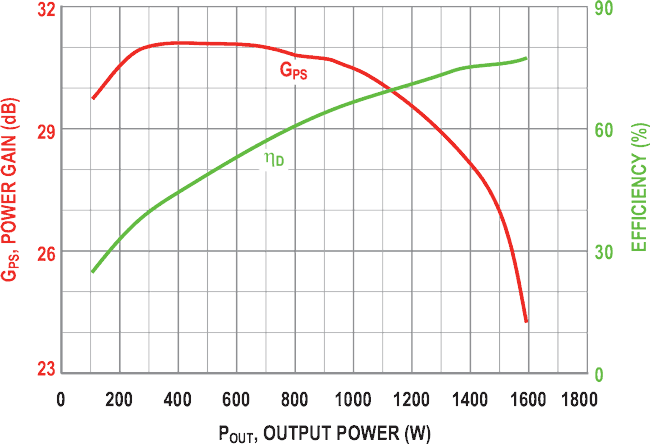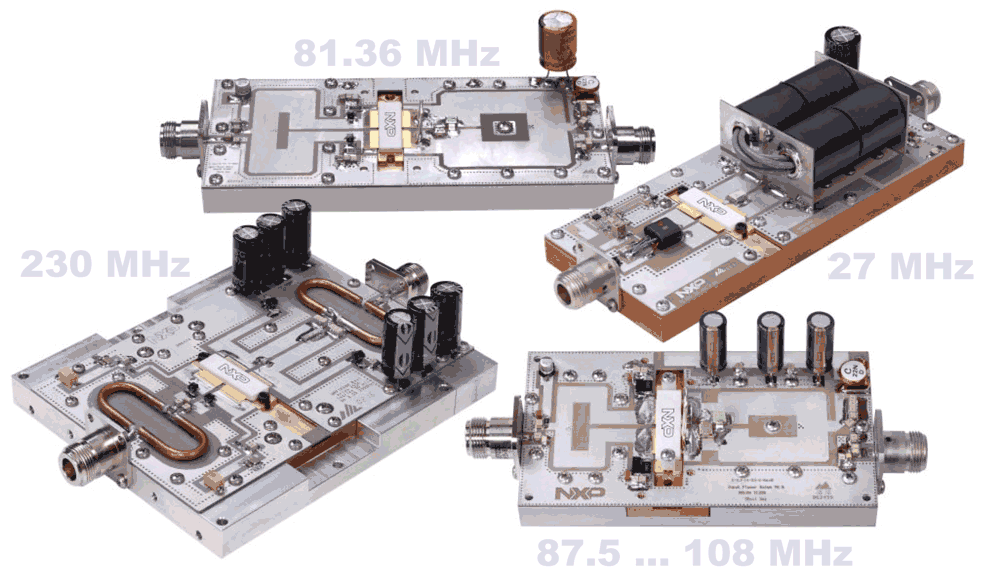John Powell, NXP Semiconductors
Microwave Engineering Europe
The latest advances in LDMOS technology have allowed RF power transistors to be employed in systems that were formerly the exclusive domain of vacuum tubes, while also expanding their use in new applications. The new NXP MRF1K50H RF power transistor further extends the capabilities of LDMOS, as it delivers 1500 W at 50 V between 1.8 and 500 MHz in either pulsed or CW operation, making it the highest power transistor available in any technology and any frequency.
When NXP introduced a 1250 W CW transistor several years ago, it became popular in a variety of high-power applications in which triode and tetrode vacuum tubes were traditionally used, as it was the first extremely rugged LDMOS transistor that could be used in systems where huge impedance mismatches can occur.
The new MRF1K50H (Figure 1) increases this level of ruggedness to even greater RF power levels and even greater ruggedness, which makes it even more appealing for these high-power applications. They include excitation of CO2 laser and plasma sources and high-energy physics applications such as particle accelerators employed in scientific or medical applications, in which they create the electromagnetic field that accelerates the particle beams.
 |
||
| Figure 1. | NXP’s new LDMOS 1.5 kW RF power transistors, shown here in their three packaging variants, produce the highest CW RF output power of any semiconductor device. The air-cavity ceramic version is pin-compatible with existing transistors – only light retuning is needed to obtain the highest power. |
|
The MRF1K50H is also well suited for use in many industrial systems such as heating, welding, and drying, in which vacuum tubes have always been used, as there were no solid-state RF power sources that combined the ruggedness of tubes with high RF output power. Other applications include FM and VHF TV broadcast transmitters, UHF radars, and land mobile radio base stations.
The MRF1K50H is also likely to become popular with manufacturers of linear amplifiers in amateur radio service, where a single transistor can comfortably produce the maximum output power (1500 W PEP) allowable on nearly all HF and some VHF bands.
 |
||
| Figure 2. | The MRF1K50H delivers 1550 W CW at 27 MHz with 25.9 dB of gain and 78% efficiency. |
|
The reliability and operating life of this transistor is substantially longer than any vacuum tube. Under extreme conditions leading to the maximum 225 °C junction temperature, the Mean-Time-To-Failure (MTTF) of the MRF1K50H will be 35 years, but in a normal operating mode with a 100 °C case temperature it is longer than 450 years. When combined with its ruggedness, the transistor ensures long-term operation without the need for replacement units or the maintenance cost and time required to install them – dramatically reducing the down time of any industrial system. Solid-state RF sources also enable power control across their full dynamic range, enabling new use cases.
 |
||
| Figure 3. | Key performance specifications for the MRF1K50H over the FM broadcast band show 81 to 84% efficiency. |
|
Output power of 1.5 kW is available in either a traditional air-cavity ceramic package (MRF1K50H) or in an over-molded plastic package (MRF1K50N). The MRF1K50H is pin-compatible with its 1250-W MRFE6VP61K25H predecessor and with devices from other manufacturers, so that RF designers can make a seamless transition to the new transistor. Not only is it built in the same package, it also exhibits a similar output capacitance making it possible to use the same printed circuit board with only minimal retuning to achieve its higher RF output power.
Designed for demanding environments
As noted earlier, the MRF1K50H is extremely rugged, capable of surviving a VSWR of 65:1 without device degradation or failure. It features a 135 V breakdown voltage (BV(dss)), with a drain-source avalanche energy absorption capability that is 40% higher than its predecessor, making it ideal for the harshest industrial environments.
 |
||
| Figure 4. | To help demonstrate the MRFK150 typical RF performance characteristics, offers four reference circuits ranging from 27 MHz to 230 MHz. |
|
High RF output power also puts stress on cooling systems. To reduce cooling requirements and increase reliability, the MRF1K50H in an air-cavity ceramic package has been designed for low thermal resistance, 0.12°C/W, and the over-molded plastic version MRF1K50N embodies the inherent benefits of copper-flange packaging such as reduced junction-to-case thermal resistance of 30%. It also ensures more precise attachment to the circuit board during manufacturing thanks to its tighter dimensional tolerances and better solder connections.
Design resources are essential complements to the introduction of any new device, so NXP offers four reference circuits dedicated to frequencies at which the MRF1K50H will most frequently be used:
- 27 MHz:
This narrowband reference design is dedicated to the most common frequency employed in industrial applications such as heat sealing, drying, and welding.
- 81.36 MHz:
Manufacturers have settled on 81.36 MHz for excitation of CO2 lasers, for which the MRF1K50H is well-suited.
- 87.5 to 108 MHz:
FM and digital radio transmitters will benefit from the very high power of the MRF1K50H, as it can reduce the number of transistors and amplifier modules required to deliver a specific RF output power at the antenna terminals. This broadband reference design expressly serves the design of the systems.
- 230 MHz:
Narrowband aerospace and other applications operating at this frequency use pulsed rather than CW signals. This reference design is designed to accommodate applications with pulse rates of 100 μs at 20% duty cycle while delivering 1500 W of peak power.
The MRF1K50H and its variants are currently in production. In addition, many of the systems in which the MRF1K50H will be used, especially those in defense and industrial applications, are expected to be in service for many years. Consequently, it’s essential for OEMs to know that key components will be available over this time period. To accommodate these applications, NXP has created a Product Longevity Program that guarantees availability of RF power transistors such as the MRF1K50H for at least 15 years after their introduction. In the case of the MRF1K50H, NXP will provide the device into least 2031.